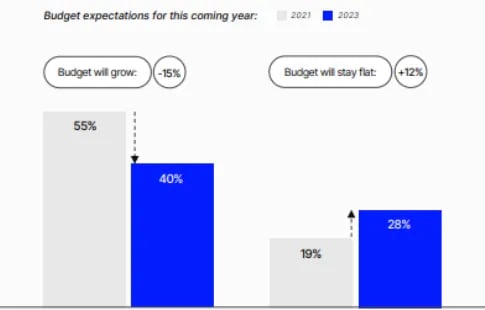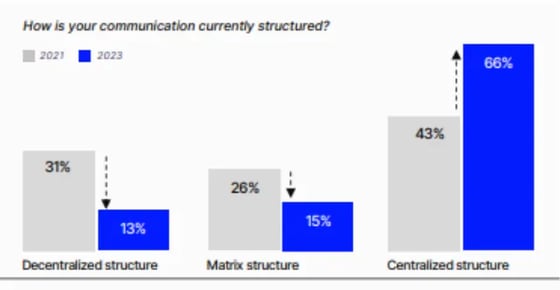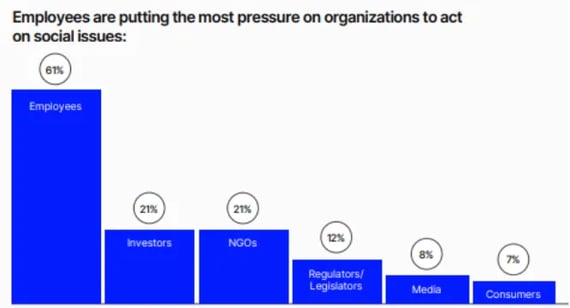The role of corporate communications is rapidly evolving as we move towards an era defined by rapid technological advancements, shifting societal values, and global interconnectedness.
Within this dynamic landscape, the 2023 Future of Corporate Communications Study, conducted by Edelman, offers invaluable insights and trends that shed light on several key developments that are shaping the landscape of this crucial business function.
Here are seven standout insights and trends from the report:
1. Communications Leaders as Strategic Advisors
There is a significant shift toward communicators becoming "value creators," emphasizing their expanded role in shaping organizational strategy. Over half of the communications leaders surveyed consider themselves strategic partners to business leaders, in stark contrast to just over a third two years ago.

- In 2021, 30% of respondents considered themselves responsive/reactive while in 2023, that number dropped to 10%.
- Earning a seat at the table remained consistent from 2021 to 2023 at 37%.
- The most notable change was the increase in those considered value creators, rising from 35% in 2021 to 52% in 2023.
However, the increasing importance of communications doesn't come without its challenges. CCOs reported spending nearly 18% of their time advising CEOs on non-communications activities, which equates to nearly one full day per week. The growing demands come from boards of directors, senior leaders, and a changing regulatory environment, which have all contributed to the intensifying role of corporate communicators.
2. Expanding Responsibilities and Budget Challenges
As the role of communicators broadens, they are now expected to manage an increasingly diverse set of stakeholders. However, resources have not kept pace with these expanding responsibilities.
Demands from boards of directors, CEOs, and other senior leaders have surged, placing pressure on communications functions to do more with limited budgets.
Additionally, budget expectations showed a shifting landscape. In 2021, 55% of organizations expected their budgets to grow, compared to 40% in 2023, while those anticipating a flat budget increased from 19% in 2021 to 28% in 2023.

3. Centralization of Communications
Communications functions are trending toward centralization, with 66% adopting centralized structures in 2023, up from 43% in 2021.
Communicators are increasingly being brought into discussions with senior leadership before decisions are made, structuring teams to align more closely with strategic priorities.
- 27% of communications experts are consulted before a decision is even taken, showcasing their involvement in strategic planning and foresight.
- 64% of communications leaders are consulted when a decision path has already been tentatively identified, highlighting their role in providing input on stakeholder considerations, aligning actions with communication strategies, and guiding decisions.
- 9% of communicators are involved after the business decision has been taken. This suggests that their expertise is still valued even after decisions are made, possibly for post-decision communication or damage control.

The structural aspect of communications functions is also changing. The report highlights a shift from decentralized and matrix structures to more centralized ones, showcasing the industry's trend towards centralization.
4. Data-Driven Decision Making Takes Center Stage
Communicators are increasingly focused on data-driven decision-making. Nearly 54% of respondents emphasized the importance of data quality and its role in shaping their communications strategies. This increased reliance on data led to a 44% increase in investments in communications technology from the previous year.
5. Multistakeholder Dynamics and Employee Empowerment
Corporate communications have become responsible for shaping an organization's purpose, and it plays a pivotal role in driving decisions and strategies related to that purpose. Employees are at the forefront of pressuring organizations to act on social issues, even more so than investors, NGOs, regulators, and other key stakeholders.

- Employees exert the highest pressure on organizations at 61%.
- Investors also hold influence, acknowledged by 21% of respondents.
- NGOs have a significant role, equally at 21%.
- Regulators/Legislators contribute but to a lesser extent, with 12% influence.
- Media wields 8% influence, shaping public perception.
- Consumers play a role with 7% influence, though less significant than other stakeholders.
6. Communications Leaders Shaping Stakeholder Capitalism
Communications play a central role in shaping the next phase of stakeholder capitalism. The integration of technology, challenges related to ESG (Environmental, Social, and Governance) considerations, and geopolitical factors are all areas where communicators will need to step up and adapt.
ESG (Environmental, Social, and Governance) considerations are becoming integral to communication strategies, and communicators are expected to lead efforts related to impact measurement, increased budget allocation, and enterprise action concerning ESG.
76% of communications leaders have fully integrated ESG (Environmental, Social, and Governance) considerations into their communications strategy.
The top three needs to drive business and impact outcomes related to ESG are better data and analytics, increased budget for communications activities, and greater enterprise action related to ESG.
7. Evolving CCO Role
Chief Communications Officers (CCOs) are experiencing turnover as the role evolves. Younger, less-tenured CCOs are more likely to collaborate closely with CEOs on communication strategies and perceive a closer working relationship with their CEOs than their organization's CMOs.
- Newer CCOs with less than five years tenure report a 90% collaboration rate on communications strategy, compared to 80% for longer-tenured CCOs.
- 69% of newer CCOs feel a closer working relationship with their CEO, while only 54% of longer-tenured CCOs share this perception.
- Newer CCOs are less impacted by the pressure to engage on social issues, with 20%, compared to 35% for longer-tenured CCOs.
The future of corporate communications is not just about conveying messages but also about guiding strategy and influencing the very essence of organizations. Adaptation, centralization, and data-driven decision-making will be key to success, as the role of corporate communicators continues to expand and diversify. Effective communications will continue to be a linchpin for organizations seeking to navigate the complexities of a rapidly changing world.
Book a demo of Sparrow Connected today.
What's Next?









